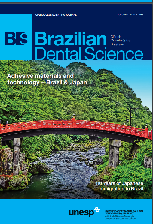Effect of beverages with different alcoholic concentration on composite resins
DOI:
https://doi.org/10.14295/bds.2018.v21i2.1516Resumo
Objective: To evaluate if alcoholic beverages can cause color change in composite resins, if the alcoholic concentration influences this variation besides analyzing within the composite resins tested, which would present greater color stability when subjected to the experiment. Material and Methods: 90 specimens of three different composite resins (IPS Empress Direct, Grandio®So and Filtek Z350 XT) were immersed in distilled water (control group), red wine and vodka. The samples were 2 mm thick and 8 mm in diameter, photopolymerized for 20 s on each side, polished with sandpaper, silicon carbide tip and felt disc with prophylactic paste and immersed in distilled water at 37 °C for 24 h prior to subgrouping. For the evaluation of the color variation, the formula prioritized by the CIEL *a *b* system was used. Data were analyzed by ANOVA and Tukey’s test at 95% significance. Results: The lowest variations occurred with the Grandio®So resin when exposed to wine, and Filtek Z350 XT when exposed to vodka. There was a statistically significant difference between the groups in water (p < 0.01) and in red wine (p < 0.01), but not in vodka (p > 0.05). The soaking medium that most caused staining was red wine. Conclusion: Red wine was the drink that generated the highest staining in all the resins tested, vodka did not change color stability significantly, the alcoholic concentrations tested did not directly influence the color change and the composite resin Grandio®So presented greater color stability when exposed to red wine.
Keywords
Alcoholic beverage; Color; Composite resin.
KEY WORDS: Alcoholic beverage, color, composite resin.
Downloads
Downloads
Arquivos adicionais
Publicado
Como Citar
Edição
Seção
Licença
TRANSFERÊNCIA DE DIREITOS AUTORAIS E DECLARAÇÃO DE RESPONSABILIDADE
Toda a propriedade de direitos autorais do artigo "____________________________________________________________________" é transferido do autor(es) para a CIÊNCIA ODONTOLÓGICA BRASILEIRA, no caso do trabalho ser publicado. O artigo não foi publicado em outro lugar e não foi submetido simultaneamente para publicação em outra revista.
Vimos por meio deste, atestar que trabalho é original e não apresenta dados manipulados, fraude ou plágio. Fizemos contribuição científica significativa para o estudo e estamos cientes dos dados apresentados e de acordo com a versão final do artigo. Assumimos total responsabilidade pelos aspectos éticos do estudo.
Este texto deve ser impresso e assinado por todos os autores. A versão digitalizada deverá ser apresentada como arquivo suplementar durante o processo de submissão.




























